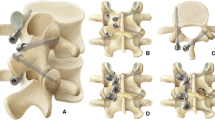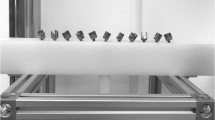Abstract
Study design
Surgical technical note and literature review.
Objectives
To describe a technique that uses 4 rod constructs in cases of complex thoracolumbar spinal deformity correction or revision surgeries based on the hybrid use of two different types of purchase points by a staggered pedicle screw fixation. It utilizes two rods on either side of the spine using a lateral and medial entry point of pedicle screws in the vertebral body.
Methods
Pedicle screws using extra-pedicular technique are more converging screws and are inserted alternately in the vertebral body and connected by rods. The left-out alternate vertebral bodies are fixed by a relatively straighter pedicle entry screw and connected to each other by a separate rod. So, two trajectories are independently used for a four-rod construct. This reconstruction has been named RCC (reinforced criss-cross construct). The screws in the index case were placed by free hand method, but we have increasingly utilized navigation guidance for placement of screws in recent times.
Results
We present a surgical technical note in a patient with human immunodeficiency virus infection and acquired immune deficiency syndrome (HIV-AIDS). He was diagnosed to have multi-drug-resistant (MDR) tuberculous spondylodiscitis, complicated with Immune reconstitution inflammatory syndrome (IRIS) and implant failure resulting in kyphosis and thoracic myelopathy. RCC with pharmacological management achieved healing and union, which was maintained at 4 years follow-up. Our method of four-rod construct provides a strong and lasting construct in the management of spinal deformities and three-column osteotomies. It provides good structural support to the spine till bony union is achieved.
Conclusion
Hybrid multi-rod construct like RCC provides a rigid mechanical support to the instrumentation and reduces the chances of rod failure especially in complex thoraco-lumbar spinal deformity correction surgeries.







Similar content being viewed by others
References
Smith JS, Shaffrey E, Klineberg E et al (2014) Prospective multicenter assessment of risk factors for rod fracture following surgery for adult spinal deformity. J Neurosurg Spine 21(6):994–1003. https://doi.org/10.3171/2014.9.SPINE131176
Yamato Y, Hasegawa T, Togawa D et al (2020) Long additional rod constructs can reduce the incidence of rod fractures following 3-column osteotomy with pelvic fixation in short term. Spine Deform 8(3):481–490. https://doi.org/10.1007/s43390-020-00071-y
Luca A, Ottardi C, Sasso M et al (2017) Instrumentation failure following pedicle subtraction osteotomy: the role of rod material, diameter, and multi-rod constructs. Eur Spine J 26(3):764–770. https://doi.org/10.1007/s00586-016-4859-8
Park PJ, Lin JD, Makhni MC et al (2020) Dual S2 alar-iliac screw technique with a multirod construct across the lumbosacral junction: obtaining adequate stability at the lumbosacral junction in spinal deformity surgery. Neurospine 17(2):466–470. https://doi.org/10.14245/ns.1938320.160
Redaelli A, Langella F, Dziubak M et al (2020) Useful and innovative methods for the treatment of postoperative coronal malalignment in adult scoliosis: the “kickstand rod” and “tie rod” procedures. Eur Spine J 29(4):849–859. https://doi.org/10.1007/s00586-019-06285-7
Dvorak M, MacDonald S, Gurr KR, Bailey SI, Haddad RG (1993) An anatomic, radiographic, and biomechanical assessment of extrapedicular screw fixation in the thoracic spine. Spine (Phila Pa 1976) 18(12):1689–1694. https://doi.org/10.1097/00007632-199309000-00018
Husted DS, Yue JJ, Fairchild TA et al (2003) An extrapedicular approach to the placement of screws in the thoracic spine: an anatomic and radiographic assessment. Spine (Phila Pa 1976) 28(20):2324–2330. https://doi.org/10.1097/01.BRS.0000085361.32600.63
Roy-Camille R, Saillant G, Mazel C (1986) Plating of thoracic, thoracolumbar, and lumbar injuries with pedicle screw plates. Orthop Clin N Am 17(1):147–159
Wei H, Dong C, Wu J et al (2020) Total en bloc spondylectomy combined with the satellite rod technique for spinal tumors. J Orthop Surg Res 15(1):536. https://doi.org/10.1186/s13018-020-02058-x (Published 2020 Nov 16)
El Dafrawy MH, Adogwa O, Wegner AM et al (2020) Comprehensive classification system for multirod constructs across three-column osteotomies: a reliability study. J Neurosurg Spine. https://doi.org/10.3171/2020.6.SPINE20678 (published online ahead of print, 2020 Oct 9)
Lindsey C, Deviren V, Xu Z et al (2006) The effects of rod contouring on spinal construct fatigue strength. Spine (Phila Pa 1976) 31(15):1680–1687. https://doi.org/10.1097/01.brs.0000224177.97846.00
Tang JA, Leasure JM, Smith JS et al (2013) Effect of severity of rod contour on posterior rod failure in the setting of lumbar pedicle subtraction osteotomy (PSO): a biomechanical study. Neurosurgery 72(2):276–283. https://doi.org/10.1227/NEU.0b013e31827ba066
Jager ZS, İnceoğlu S, Palmer D et al (2016) Preventing instrumentation failure in three-column spinal osteotomy: biomechanical analysis of rod configuration. Spine Deform 4(1):3–9. https://doi.org/10.1016/j.jspd.2015.06.005
Kelly BP, Shen FH, Schwab JS et al (2008) Biomechanical testing of a novel four-rod technique for lumbo-pelvic reconstruction. Spine (Phila Pa 1976) 33(13):E400–E406. https://doi.org/10.1097/BRS.0b013e31817615c5
Makhni MC, Cerpa M, Lin JD et al (2018) (2018) The “Kickstand Rod” technique for correction of coronal imbalance in patients with adult spinal deformity: theory and technical considerations. J Spine Surg 4(4):798–802. https://doi.org/10.21037/jss.2018.11.04
Kostuik JP, Hall BB (1983) Spinal fusions to the sacrum in adults with scoliosis. Spine (Phila Pa 1976) 8(5):489–500. https://doi.org/10.1097/00007632-198307000-00006
Balderston RA, Winter RB, Moe JH et al (1986) Fusion to the sacrum for nonparalytic scoliosis in the adult. Spine (Phila Pa 1976) 11(8):824–829. https://doi.org/10.1097/00007632-198610000-00017
Shen FH, Harper M, Foster WC et al (2006) A novel “four-rod technique” for lumbo-pelvic reconstruction: theory and technical considerations. Spine (Phila Pa 1976) 31(12):1395–1401. https://doi.org/10.1097/01.brs.0000219527.64180.95
Shen FH, Qureshi R, Tyger R et al (2018) Use of the “dual construct” for the management of complex spinal reconstructions. Spine J 18(3):482–490. https://doi.org/10.1016/j.spinee.2017.08.235
Morgenstern W, Ferguson SJ, Berey S et al (2003) Posterior thoracic extrapedicular fixation: a biomechanical study. Spine (Phila Pa 1976) 28(16):1829–1835. https://doi.org/10.1097/01.BRS.0000083280.72978.D1
Funding
The authors did not receive support from any organization for the submitted work.
Author information
Authors and Affiliations
Contributions
Concept hypothesis: AK. Manuscript writing: AK, AR, SM, MD, BRD, UM, DD, RRR. Images/illustration making and editing: AR. Collection and assembly of data with analysis/interpretations: UM, DD, RRR. Revision: SM, MD, BRD, AK, UM, AR, DD, RR. Proof reading and final approval of manuscript: SM, MD, BRD, AK, UM, AR, DD, RR. Approval for investigation and doubt resolution: SM, MD, BRD, AK, UM, AR, DD, RRR.
Corresponding author
Ethics declarations
Conflict of interest
The authors have no relevant financial or non-financial interests to disclose.
Ethical approval
Approval was obtained from the ethics committee of the Hospital where the study was conducted. The procedures used in this study adhere to the tenets of the Declaration of Helsinki.
Informed consent
Informed consent was obtained from all individual participants included in the study. Patients signed informed consent regarding publishing their data and photographs.
Additional information
Publisher's Note
Springer Nature remains neutral with regard to jurisdictional claims in published maps and institutional affiliations.
Rights and permissions
About this article
Cite this article
Krishnan, A., Raj, A., Meena, U. et al. RCC (reinforced criss-cross construct): an easy and effective multi-rod thoraco-lumbar posterior reconstruction technique. Spine Deform 10, 1203–1208 (2022). https://doi.org/10.1007/s43390-022-00504-w
Received:
Accepted:
Published:
Issue Date:
DOI: https://doi.org/10.1007/s43390-022-00504-w




